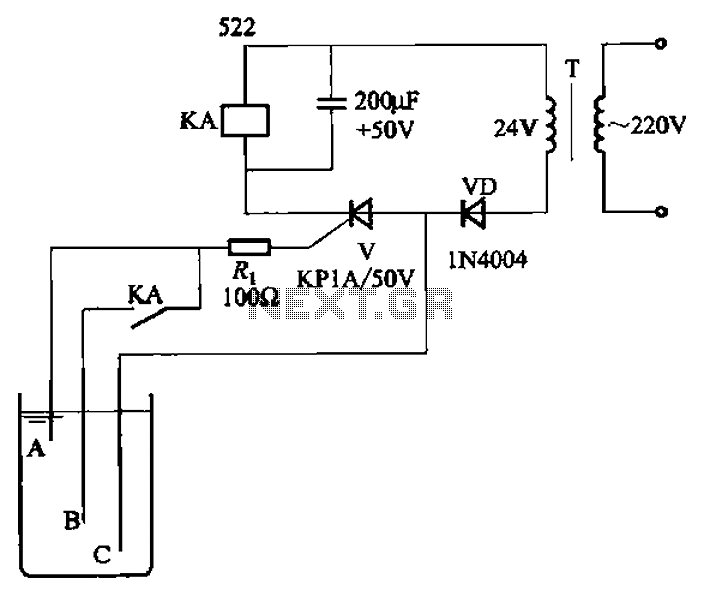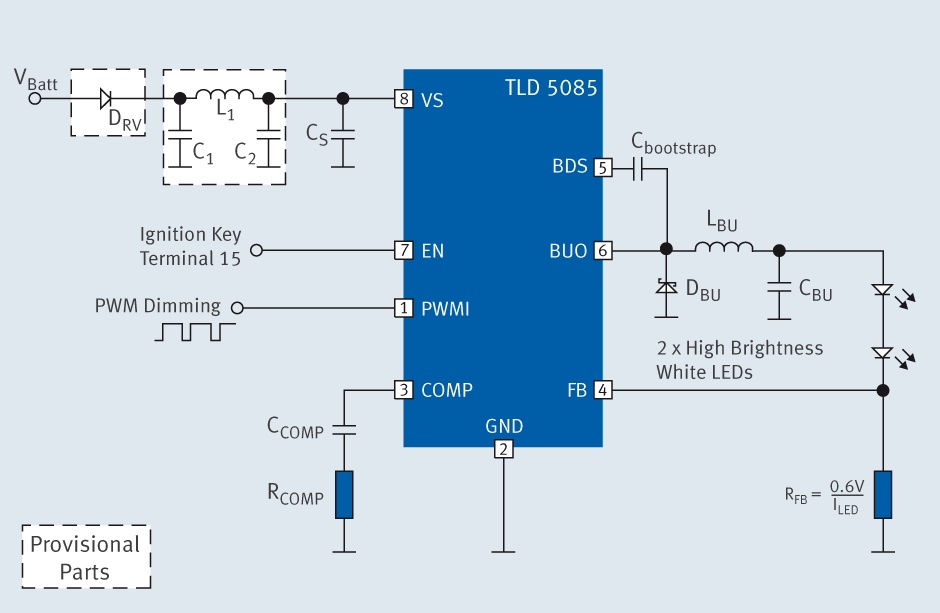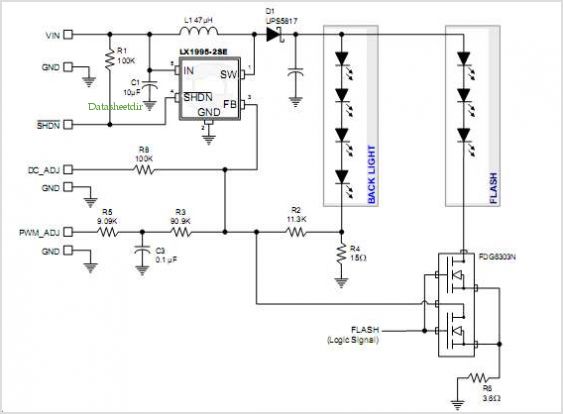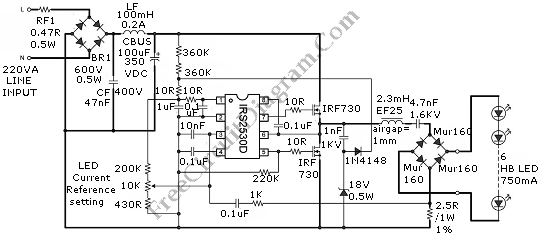
solar led
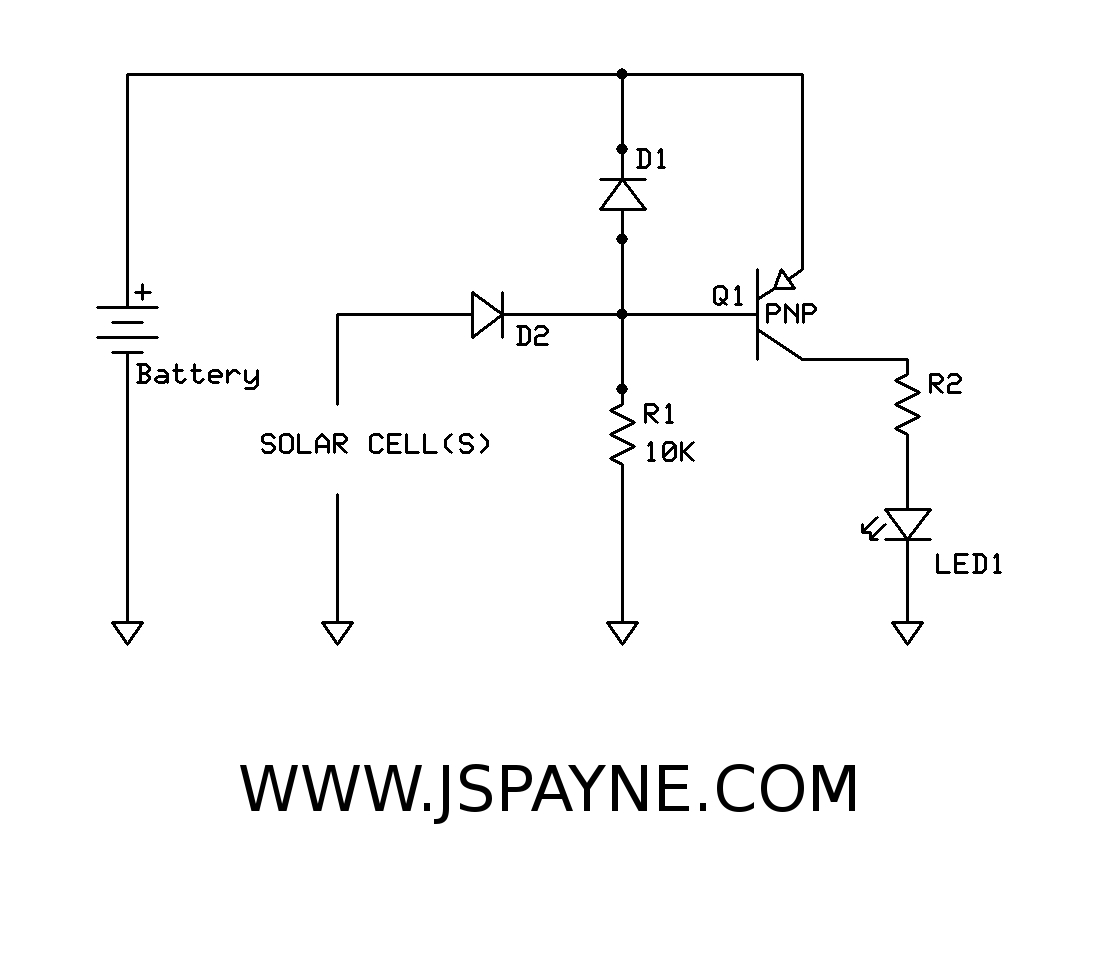
This circuit was developed in response to the observation that many solar LED lights utilizing a CDS light sensor appeared to have an excessive number of components. The intention was to simplify the design. This circuit does not incorporate a voltage boost feature, which is typically required to operate a white LED from a voltage source of less than 3 volts. However, when using a 3.8-volt cell, it is possible to drive a white LED. For lower voltage cells, various color LEDs, such as green, red, and orange, can still be utilized. It is important to select a solar cell with a voltage greater than the battery voltage plus 1.4 volts. The solar cell charges the battery through diodes D1 and D2. During the charging phase, the voltage at the base of the transistor turns off the PNP transistor. In the absence of light on the solar cell, the voltage at D1, D2, and the base drops, allowing current to flow through the emitter/base junction of the PNP transistor and resistor R1, thereby turning the PNP transistor on. Consequently, current flows from the battery through resistor R2, which limits the current to the LED, allowing it to illuminate.
This circuit operates based on a straightforward principle of solar energy conversion and LED illumination. The core components include a solar cell, a rechargeable battery, two diodes (D1 and D2), a PNP transistor, and two resistors (R1 and R2).
The solar cell is responsible for converting sunlight into electrical energy, which charges the battery. The choice of a solar cell must be carefully considered; it should have an output voltage that exceeds the battery voltage by at least 1.4 volts to ensure efficient charging. Diodes D1 and D2 play a critical role in preventing reverse current flow, ensuring that the battery is charged effectively while also protecting the circuit from potential damage.
The PNP transistor serves as a switch in the circuit. During daylight, when the solar cell is generating voltage, the base of the PNP transistor receives a higher voltage, effectively turning it off and preventing current from flowing to the LED. Conversely, in the absence of light, the voltage at the base drops, turning the transistor on and allowing current to flow from the battery through resistor R2 to the LED. Resistor R2 is essential for current limiting, ensuring that the LED operates within its safe current range, thereby extending its lifespan and maintaining optimal performance.
Overall, this circuit design emphasizes simplicity and efficiency, allowing for the practical implementation of solar-powered LED lighting with a minimal number of components while ensuring reliable operation across different LED color types.I developed this circuit because I kept seeing solar LED lights for sale that use a CDS light sensor and just seemed to have more components than necessary. It just seemed like it did not need to be that complicated. This circuit does not do any voltage boost that would be necessary to drive a white led from a voltage source of less than 3 volts.
If you use a 3. 8 volt cell you can drive a white led with this circuit. If you use lower voltage cell(s) you can still drive many other color LEDs (i. e. green, red, orange. ). NOTE: you must choose a solar cell(s) that is greater than your battery voltage + 1. 4 volts. The solar cell charges the battery through D2 and D1, the voltage on the base of the transistor during charging mode turns off the PNP transistor. When there is no light on the solar cell, the voltage at the D1, D2, and base goes low, when this happens current flows through the emitter/base of the PNP transistor and R1, thereby biasing the PNP transistor on.
Now current will flow from the battery through R2 and turn on the LED. R2 is used to current limit the current thorough the LED. 🔗 External reference
This circuit operates based on a straightforward principle of solar energy conversion and LED illumination. The core components include a solar cell, a rechargeable battery, two diodes (D1 and D2), a PNP transistor, and two resistors (R1 and R2).
The solar cell is responsible for converting sunlight into electrical energy, which charges the battery. The choice of a solar cell must be carefully considered; it should have an output voltage that exceeds the battery voltage by at least 1.4 volts to ensure efficient charging. Diodes D1 and D2 play a critical role in preventing reverse current flow, ensuring that the battery is charged effectively while also protecting the circuit from potential damage.
The PNP transistor serves as a switch in the circuit. During daylight, when the solar cell is generating voltage, the base of the PNP transistor receives a higher voltage, effectively turning it off and preventing current from flowing to the LED. Conversely, in the absence of light, the voltage at the base drops, turning the transistor on and allowing current to flow from the battery through resistor R2 to the LED. Resistor R2 is essential for current limiting, ensuring that the LED operates within its safe current range, thereby extending its lifespan and maintaining optimal performance.
Overall, this circuit design emphasizes simplicity and efficiency, allowing for the practical implementation of solar-powered LED lighting with a minimal number of components while ensuring reliable operation across different LED color types.I developed this circuit because I kept seeing solar LED lights for sale that use a CDS light sensor and just seemed to have more components than necessary. It just seemed like it did not need to be that complicated. This circuit does not do any voltage boost that would be necessary to drive a white led from a voltage source of less than 3 volts.
If you use a 3. 8 volt cell you can drive a white led with this circuit. If you use lower voltage cell(s) you can still drive many other color LEDs (i. e. green, red, orange. ). NOTE: you must choose a solar cell(s) that is greater than your battery voltage + 1. 4 volts. The solar cell charges the battery through D2 and D1, the voltage on the base of the transistor during charging mode turns off the PNP transistor. When there is no light on the solar cell, the voltage at the D1, D2, and base goes low, when this happens current flows through the emitter/base of the PNP transistor and R1, thereby biasing the PNP transistor on.
Now current will flow from the battery through R2 and turn on the LED. R2 is used to current limit the current thorough the LED. 🔗 External reference
